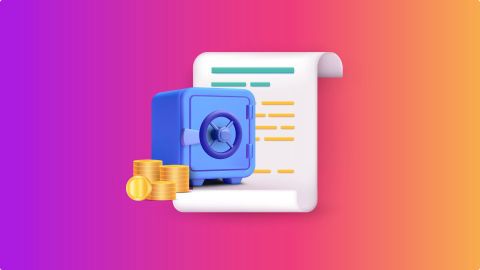What are the provident fund benefits?
The Employees’ Provident Fund (EPF) is one of the most popular and essential savings schemes for salaried employees in India. It provides financial security and long-term benefits. The key advantages of the EPF scheme are:
- Tax benefits: Both the contributions made and the interest earned are tax-exempt. If the accumulated amount is withdrawn after five years, it remains tax-free. However, withdrawing before five years makes the amount taxable.
- Wealth accumulation: The government decides the interest rate for EPF, and contributions are made monthly. Since the amount compounds over time, employees can build a substantial corpus without making a lump sum investment.
- Retirement savings: EPF ensures financial security post-retirement by helping employees accumulate a stable retirement fund, providing independence and long-term stability.
- Emergency fund: The accumulated balance can be used to manage unexpected financial crises. Employees can withdraw a partial amount in case of emergencies.
- Support during unemployment: If an employee loses their job, they can withdraw 75% of their EPF balance after one month of unemployment. The remaining 25% can be withdrawn after two months of continued unemployment.
How does provident fund work?
Step 1: Deduction of EPF from salary
For every salaried employee, certain deductions are made from the monthly salary, one of which is for the Employee Provident Fund (EPF). This deduction is clearly mentioned in the salary slip. As per EPF regulations, 12 percent of an employee’s salary is contributed towards the provident fund. The employer also contributes 12 percent, out of which 8.33 percent is allocated to the Employee Pension Scheme (EPS) and the remaining 3.67 percent goes into the EPF account.
Step 2: Pooling and investment of EPF funds
The contributions made by employees and employers are pooled together and managed by a trust. These funds are invested and generate interest at a rate set by the government, usually ranging between 8 to 12 percent. The accumulated balance continues to grow due to monthly contributions and the effect of annual compound interest. The EPF remains active until the employee decides to withdraw it, typically at the time of retirement.
Step 3: Withdrawal of Employee Provident Fund
There are two ways to withdraw funds from an EPF account.
- The first is upon reaching the retirement age of 58 years, after which an employee can withdraw the accumulated EPF balance by applying through their employer.
- The second is before reaching retirement age. If an individual is unemployed for at least one month, they are allowed to withdraw 75 percent of their provident fund balance. However, the employer’s contribution can only be withdrawn once the employee turns 58 years old.
If you’re considering withdrawing your EPF balance after switching jobs or retirement, remember that reinvesting those funds wisely can help grow your wealth further. Instead of letting your EPF withdrawal sit idle, you can invest in a Fixed Deposit with Bajaj Finance and earn interest rates of up to 8.60% p.a.—ensuring your hard-earned money continues to work for you. Book your FD today.
Eligibility Criteria for Employee’s Provident Fund
The following are the eligibility requirements for enrolling in the EPF scheme:
- Registration for an EPF account is required for salaried employees earning Rs. 15,000 per month inclusive of the basic wages and dearness allowance.
- If a company employs more than 20 people, it is required by law to enroll in the EPF plan.
- A business with less than 20 employees may join the EPF plan on a voluntary basis.
- Employees earning more than Rs. 15,000 can open an EPF account, but they must first receive permission from their employer and the Assistant PF commissioner.
- The EPF scheme's requirements apply to the entire country of India (except for the states of Jammu and Kashmir).
Also read: How to Change Mobile Number in EPF
Types of Provident Funds
There are mainly three different types of PFs, which are as follows:
- The general Provident Funds is a type of PF maintained by government bodies, including local authorities, the railways, and other such bodies.
- The recognised Provident Fund is the one that applies to all privately owned organisations that have more than 20 employees. Moreover, holding a rightful claim to the PF associated with your organisation, you will be given a UAN or Universal Account Number. This enables you to transfer your PF funds from one employer to another whenever you move from one occupation to another.
- The public provident fund is defined by the voluntary nature of investment on the part of the employee. The PPF is also associated with a minimum deposit of Rs. 500 and a maximum amount of Rs. 1.5 lakh. The PPF has a lock-in period of 15 years.
Besides the PF, another safe investment that enables wealth generation is the Bajaj Finance Fixed Deposit. With this provision, you enjoy the benefit of attractive FD interest rates at flexible investment tenure options. Another advantage is the Bajaj Finance FD, which allows you to invest conveniently through a 100% digital process.
Provident Fund contribution
Both the employer and employee make equal contributions to the EPF account as shown below.
Contribution by
|
Monthly Percentage Contributed
|
Employer
|
12.00%
|
Employee
|
12% or 10%
|
Total
|
24.00%
|
Points to Consider When Making an EPF Contribution
- Employer’s 12% contribution includes 3.67% EPF and 8.33% EPS.
- 10% EPF is valid for
- Organisations with 20 or less employees.
- Organisations with losses more than or equal to net worth (at the end of the financial year).
- Organisations declared sick by the Board for Industrial and Financial Reconstruction.
- The EPF passbook is updated with all donations.
- The employee's contribution is applied entirely to the employee's Provident Fund.
- Aside from the contributions already made, the employer must contribute an extra 0.5 percent to EDLI.
- The employer must additionally pay some administration charges for EDLI and EPF, which are 1.1% and 0.01%, respectively. This means that the employer is required to contribute a total of 13.61% of the employee's salary to the plan.
How to check your PF balance
Those looking to check their PF details must have an active Universal Account Number (UAN), which can help them review their PF account balance. Here are the steps to check your Provident Fund online balance:
- Visit the EPFO website.
- Enter your UAN and password.
- View and download your EPF account statement.
You can also check your balance by giving a missed call on 9966044425, from your registered phone number.
PF balance check by sending an SMS
UAN activated members can check their latest PF contribution and balance available with EPFO by sending an SMS at 7738299899 from registered mobile number. “EPFOHO UAN״ to 7738299899.
PF balance check through a missed call
An EPFO member can check their PF balance by using EPFO missed call service by giving a missed call on 9966044425 from its UAN registered mobile number.
PF balance check using the Umang/ EPFO app
Here is how one can check the PF balance by using the Umang/ EPFO app:
- After downloading the Umang/ EPFO app, click on 'member' and then go to 'balance/ passbook'.
- Enter your UAN and registered mobile number. The system will verify your mobile number against your UAN. If all the details are verified, you can view your updated EPF balance details.
How to withdraw, claim or transfer PF?
When it comes to withdrawing funds from your PF account, you can either choose to submit a physical application or an online application. The best way to do this is to visit the EPFO website and use any of the following means to initiate a transfer or a withdrawal process:
- UAN
- Digital signature
- Aadhaar Card and personal details
You can also read about Provident Fund information online on the EPFO website. For PF online transfer, the form that needs to be filled up is Form 13. On the other hand, the documents associated with withdrawal or claims include Form 31 (part withdrawal of PF funds), Form 10C (pension withdrawal) and Form 19 (final PF settlement).
Invest in fixed deposit
When you withdraw money from your Provident Fund account, you get a surplus amount to use as your retirement fund. You can consider investing in fixed deposits to protect your Provident Fund amount from market fluctuations and earn high returns.
Bajaj Finance Fixed Deposit offers one of the highest interest rates, up to 8.35% p.a. for customers below the age of 60, going up to 8.60% p.a. for senior citizens. You can also choose the tenure and frequency of your interest payouts.
To calculate the maturity amount of fixed deposit amount, Use FD calculator.
Calculate your expected investment returns with the help of our investment calculators












